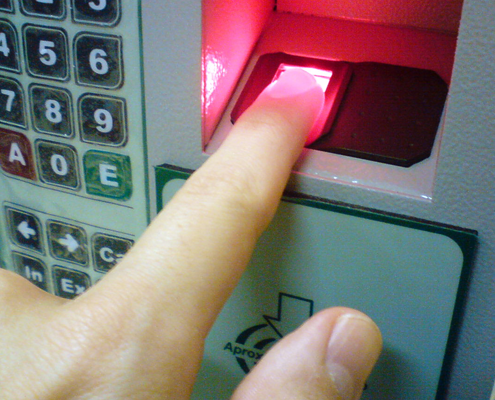University of Maine deploys @M2SYS Palm Vein Scanners for student check-in at dining halls
University using the M2SYS Hybrid Bio-SnapOn™ platform with Palm Vein Scanner and Bio-Hyperserver™ multi-biometric identification matching server
Atlanta, GA (January 10, 2012) – M2SYS Technology and the University of Maine have teamed up to implement palm vein scanner biometric software with their point-of-service (POS) software for student check-in at on-campus dining halls. Seeking a biometric student identification system to efficiently and effectively track and manage dining hall traffic, the University of Maine turned to the flexible M2SYS Hybrid Bio-SnapOn™ Platform and palm vein scanner, which uses vascular biometrics for accurate identification. The deployment is expected to save thousands of dollars per by year by eliminating shared cards, a practice that has students share their meal plans at a price of $4,100 per academic year.
University officials chose the M2SYS Hybrid Bio-SnapOn™ software and palm vein scanner because it is a complete biometric software system that can be instantly interfaced with their lunch line POS software, without any code-level development. The University also chose to deploy Bio-Hyperserver™, a high-performance, scalable, hyper-threaded multi-biometric identification server designed for exceptionally fast matching speeds in biometric projects with larger databases.
Bio-Hyperserver™ is a perfect fit for large-scale biometric deployments that require high reliability and speed like the University of Maine. Examples of verticals that can benefit from Bio-Hyperserver™ include: lunch line POS, patient identification across health care networks, inmate identification within detention centers, banking institution customer identification, and government biometric deduplication projects such as voting, passport issuance and national ID.
“We are pleased to be partnering with the University of Maine to deliver our Hybrid Bio-SnapOn™ software, M2-PalmVein™ palm vein scanner, and Bio-Hyperserver™ multi-biometric server to facilitate efficient and rapid identification for students with their lunch line POS software” said Michael Trader, President of M2SYS. “We see more Universities using the palm vein scanner to reduce expenses, prevent identity fraud and increase convenience. Our Hybrid Bio-SnapOn™ multi-biometric software has helped to facilitate the safe and orderly management of the University’s student member information and our Bio-Hyperserver™ server ensures that search results are returned instantaneously. ”
“We are happy with our choice to deploy the palm vein scanner and the M2SYS Hybrid Bio-SnapOn™ multi-biometric software at our on-campus dining halls to reduce expenses and eliminate the sharing of ID cards,” said Benny Veenhof, Director of Technology Management at the University. “We sought a solution that would eliminate the need for ID cards in our dining facilities, verify students quickly and accurately, and enhance the student dining experience. Considering the size of our database, adding the Bio-Hyerpliance™ server to our deployment has improved search speeds and ensured convenience for the entire system.”
About M2SYS Technology
M2SYS Technology, www.m2sys.com, provides technology that makes biometric software affordable, simple to integrate and inexpensive to support enabling customers to easily utilize the right form of biometric technology for their needs. The M2SYS Corporate Blog can be found at blog.m2sys.com.
Contact:
M2SYS Technology
John Trader
Communications Specialist
john@m2sys.com
770-393-0986 x34
Business solutions
Looking to protect your vital assets and save money by securing your PC/network, managing passwords, and eliminating identity fraud? Look no further than our business solutions.
Support services
Our unique service and support model helps our customers to reach the full potential of their biometrics investment. The secret? The human aspect.
Fingerprint SDK
Need to integrate fingerprint biometrics into your application? Our core technology solutions enable you to integrate a complete system without the burden of a low level fingerprint SDK.





